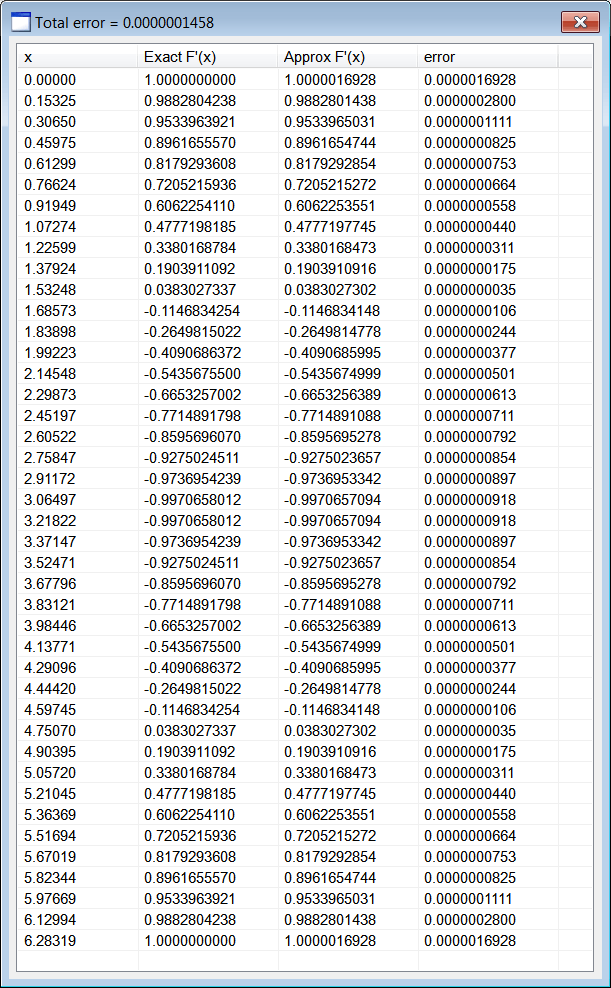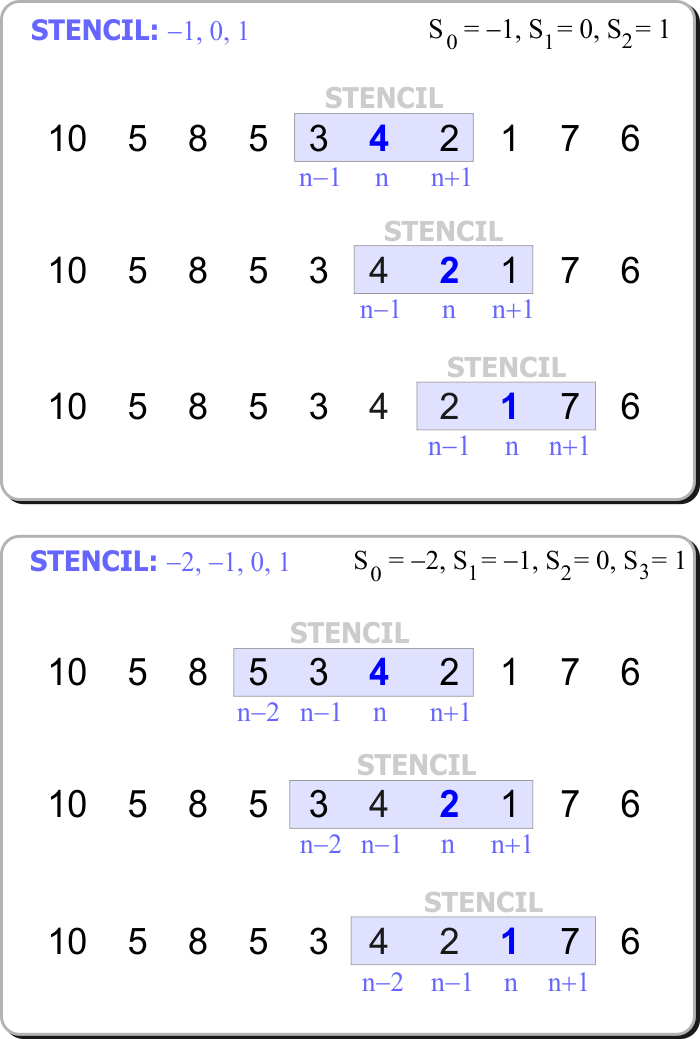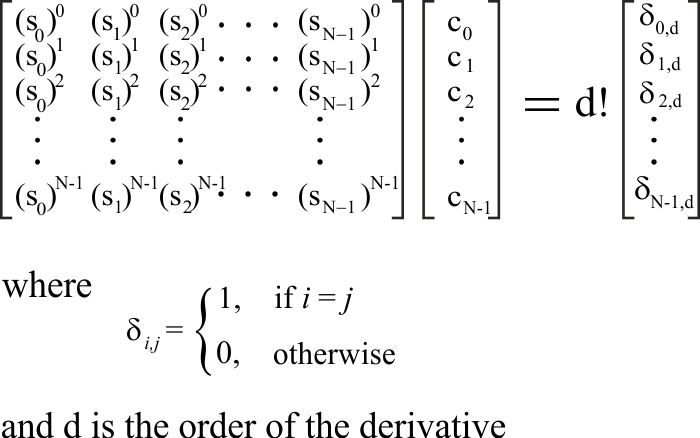Numerical Differentiation (Derivative) |
| It is a set of methods that are used to estimate the numerical value of the derivative of a function. Es un conjunto de métodos usados para estimar el valor numérico de la derivada de una función. |
| Problem 1 |
| Cree a Dialog application called FiniteDifference using Wintempla to estimate the derivative of y = sin( x) in the range from 0 to 6.2832. After creating the application, insert a List View control called lvOutput. Cree un aplicación de Dialogo programa llamado FiniteDifference usando Wintempla para estimar la derivada de de y = sin( x) en el rango desde 0 a 6.2836. Después de crear el programa, inserte un control de List View llamado lvOutput. |

| FiniteDifference.cpp |
| ... void FiniteDifference::Window_Open(Win::Event& e) { //________________________________________________________ 1. List view column setup lvOutput.Cols.Add(0, LVCFMT_LEFT, 120, L"x"); lvOutput.Cols.Add(1, LVCFMT_LEFT, 140, L"Exact F'(x)"); lvOutput.Cols.Add(2, LVCFMT_LEFT, 140, L"Approx F'(x)"); lvOutput.Cols.Add(3, LVCFMT_LEFT, 140, L"error"); //________________________________________________________ 2. Compute x and f(x) const size_t count = 42; const double delta = (2.0*M_PI)/(count-1.0); valarray<double> x(count); valarray<double> fx(count); int i; for (i = 0; i < count; i++) { x[i] = i*delta; fx[i] = sin(x[i]); } //________________________________________________________ 3. Compute approxDerivative valarray<double> approxDerivative; Math::NumericDerivative::FirstDerivative(delta, fx, approxDerivative); //________________________________________________________ 4. Display results wchar_t text[64]; double exactDerivative = 0.0; double error = 0.0; double totalError = 0.0; for (i = 0; i < count; i++) { //______________________________________ 4.1. x _snwprintf_s(text, 64, _TRUNCATE, L"%.5f", x[i]); lvOutput.AddItem(i, text, 0, 0); //______________________________________ 4.2. Exact F'(x) exactDerivative = cos(x[i]); _snwprintf_s(text, 64, _TRUNCATE, L"%.10f", exactDerivative); lvOutput.SetItemText(i, 1, text); //______________________________________ 4.3. Approx F'(x) _snwprintf_s(text, 64, _TRUNCATE, L"%.10f", approxDerivative[i]); lvOutput.SetItemText(i, 2, text); //______________________________________ 4.4. Error error = fabs(exactDerivative - approxDerivative[i]); _snwprintf_s(text, 64, _TRUNCATE, L"%.10f", error); lvOutput.SetItemText(i, 3, text); totalError += error; } //________________________________________________________ 5. Display error _snwprintf_s(text, 64, _TRUNCATE, L"Total error = %.10f", totalError/count); this->Text = text; } |
Stencil |
| It is a set of points that are arranged in the vicinity of a point of interest. The figure below illustrates two one-dimensional stencils. The first stencil has three points: one before the point of interest (n-1), the point of interest (n) and one after the point of interest (n+1). When the point of interest changes, all the points in the stencil also change. The second stencil has four points: n-2, n-1, n and n+1. Es un conjunto de punto que se acomoda en la vecindad del punto de interés. La figura de abajo ilustra dos stencils de una dimensión. El primer stencil tiene tres puntos: uno antes del punto de interés (n-1), el punto de interés (n) y uno después del punto de interés (n+1). Cuando el punto de interés cambia todos los puntos del stencil también cambian. El segundo stencil tiene cuatro puntos: n-2, n-1, n y n+1. |

Fine difference coefficients |
| Each stencil is associated with a set of finite difference coefficients: c0, c1, c2, ..., cN-1. One method to compute these coefficients is by using a Taylor expansion as shown below. Cada stencil está asociado con un conjunto de coeficientes de diferencias finitas: c0, c1, c2, ..., cN-1. Un método para calcular estos coeficientes es usando una expansión de Taylor como se muestra debajo. |

| Problem 2 |
| Cree a Dialog application called FiniteCoeff using Wintempla to estimate finite difference coefficients. Cree un aplicación de Dialogo programa llamado FiniteCoeff usando Wintempla para estimar los coeficientes de diferencias finitas. |

| FiniteCoeff.cpp |
| ... void FiniteCoeff::btCompute_Click(Win::Event& e) { //__________________________________________________ 1. Read: stencil and order valarray<double> stencil; Sys::Convert::ToVector(tbxStencil.Text, stencil); const int N = (int)stencil.size(); const int d = tbxOrder.IntValue; //__________________________________________________ 2. Create matrix MATRIX a; Math::Oper::CreateMatrix(a, N, N); int i, j; for (j = 0; j < N; j++) a[0][j] = 1.0; for (j = 0; j < N; j++) a[1][j] = stencil[j]; for (i = 2; i < N; i++) { for (j = 0; j < N; j++) { if (i%2 == 0) { a[i][j] = pow(fabs(stencil[j]), (double)i); } else { a[i][j] = pow(fabs(stencil[j]), (double)i); if (stencil[j] < 0.0) a[i][j] *= -1.0; } } } //__________________________________________________ 3. Create b valarray<double> b; b.resize(N); for (i = 0; i < N; i++) { if (i == d) { b[i] = Math::Oper::Factorial(d); } else { b[i] = 0.0; } } //__________________________________________________ 4. Solve the system of equations valarray<double> s, x; MATRIX v; const wchar_t* error = Math::SingValDecompos::Decompose(a, s, v); if (error) { this->MessageBox(error, L"FiniteCoeff", MB_OK | MB_ICONERROR); return; } if (Math::SingValDecompos::BackSubstitution(a, s, v, b, x) == false) { this->MessageBox(L"Error Math::SingValDecompos::BackSubstitution", L"FiniteCoeff", MB_OK | MB_ICONERROR); } //__________________________________________________ 5. Display coefficients wstring text; Sys::Convert::ToString(x, text); tbxCoeff.Text = text; } |